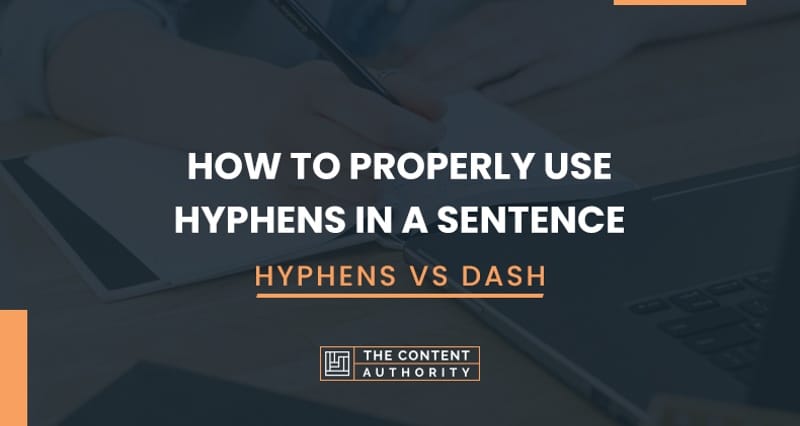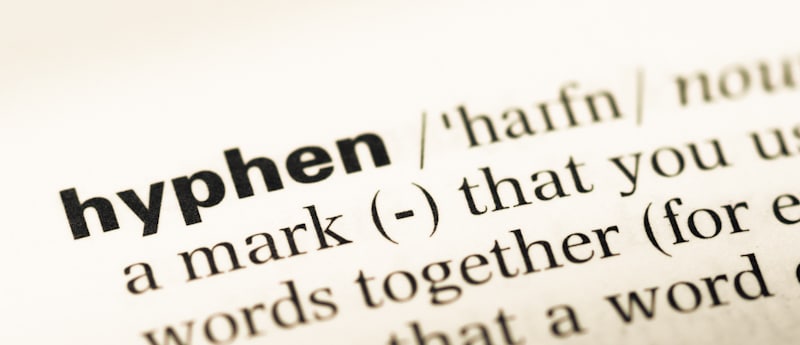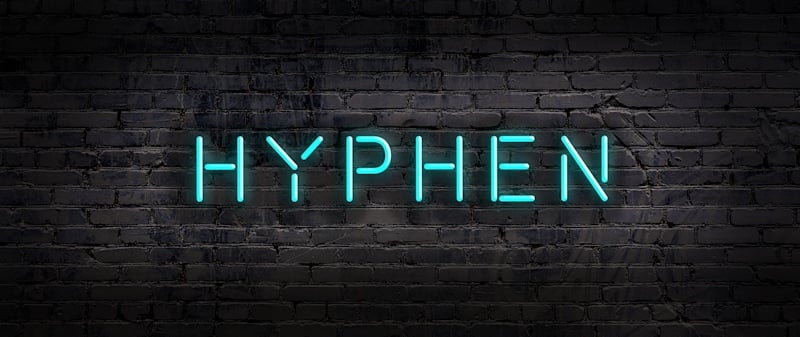Knowing when and how to use hyphens and dashes is a critical art of writing effectively. There are some conflicting rules on whether to use the codes for an en or em dash or type two — or three hyphens together — as shown.
Hyphens and dashes cause confusion, but the simple rule on how to use them in a sentence is that hyphens join two or more words or parts of words together, while dashes separate phrases from other content. Hyphens and dashes are not interchangeable, and you should learn the differences between them.
The Rules Of Hyphenation
Hyphens are used to connect two words, such as compound modifiers like “load-bearing walls” or “the skirt was a blue-green color.” Other examples of compound modifiers include:
- The 40-hour workweek has become a thing of the past.
- He won the 100-meter sprint.
- Arthur Conan Doyle was a nineteenth-century novelist who created Sherlock Holmes.
Compound modifiers can include nouns, adjectives, adverbs and present participles, which are verbs ending in “ing.” Examples include “handsome-looking man” and “fast-acting medication.” You might have noticed that each of these compound modifiers immediately comes before the word it modifies. When the modifier comes after the word it modifies, ho hyphen is used. Examples include ¨the man is handsome looking¨ and ẗhe medicine is fast acting.
Writing Numbers And Fractions With Hyphens
Fractions use hyphens when written out in verbiage. For example “sixty-three one-hundredths of an inch.” Numbers higher than twenty are also written with a hyphen, such as sixty-four, seventy-eight and twenty-seven add up to one-hundred-sixty-nine. When writing out money, you substitute “and” for the hyphen between cents: three-hundred-fifty dollars and fifty-two cents.
When using written words or digits in compound adjectives, connect the words with a hyphen: He gave a 10-minute speech. When the number comes at the end of the compound modifier, a hyphen isn’t used. Examples of these cases include:
- He has Type-2 diabetes.
- He took a 12-minute survey.
- He is an expert in eighteenth-century literature.
- He threw a rock through the third-floor window.
- The umpire called ball-4, which forced in a homerun to win the game.
Hyphens Using Past Participles
Compound modifiers using past participles employ the same rules as modifiers with present participles. If the compound modifier precedes the word it modifies, you use a hyphen. If it follows the word it modifies, no hyphen is required. Examples include:
- My battery-powered drone gives me super spying powers.
- The well-known performer demonstrated magic to our group.
- Meat-fed plants are creepy.
- My drone is battery-powered.
- The magician is well known in entertainment circles.
- Venus fly traps are meat fed plants.
Compound Words And Non-Hyphenated Words
As usage becomes common, some compound words are no longer hyphenated because they become a single word or two separate words. A dictionary helps you track whether a compound word modifier is two words or a single word. Examples of these compound modifier words include:
- I ate dinner in the living room in front of the TV.
- The candy’s in a dish on the coffee table.
- He’s a teenager now.
- She went to the bookstore instead of the library.
- Many policemen and firemen died during the 9-11 terrorist attacks.
Adverbs That End In “Ly” And Comparatives
Adverbs that end in “ly” and comparatives and superlatives like better and best are not hyphenated in compound modifiers either before or after the modified noun. Examples include:
- He was the best dancing partner she ever found.
- He was a better known drinker than a dancer.
- She was best known as a gifted public speaker.
- He was a faster shooting gunslinger who only failed once.
- He was the cheapest buying sponsor the team ever had.
- The softer feeling pillow resulted in my getting no sleep.
- The luckier betting kid did better than all the adults.
- The happily married man resisted the temptations he found at the convention.
Using High And Low In Compound Modifiers
Like most compound modifiers, using high and low as part of a modifier requires a hyphen when using it before the noun it modifies. Sentence examples include:
- Kathy called Susie a low-born tramp.
- Credit cards carry excessively high-interest rates.
- I didn’t get invited to the high-level meeting.
- My low-flying drone isn’t allowed to fly near airports.
- Susie is not a low born tramp as Kathy suggests.
- My credit card has unusually high interest.
- The meeting was high level, and I wasn’t invited.
- My drone is low flying to avoid observation.
Words That Become Closed Compounds
Advances in digital tech have increased the number of new compound words in our vocabulary. Words like e-commerce and e-mail are perfect examples. The Associated Press updates its lists every year, and email is now considered correct. People in e-commerce often insist on spelling the word eCommerce.
Depending on what you’re writing, you can write compound modifiers based on popular culture, AP guidelines or the Chicago Manual of Style. You’ll find variations of the spellings of cell phone and cellphone, home page and homepage, e-commerce and eCommerce, etc.
Hyphenated Multi Word Phrases And Use Of Multi
Hyphenated multi word phrases include words like mother-in-law, editor-in-chief, 18-year-old, master-at-arms, etc. You can also string compound modifiers to fit your identifying needs like: We’d like to test all more-than-average-weight seniors at the clinic. The use of multi, which is itself an abbreviation of multiple, is often recommended by spell checkers as a separate word. It is technically a prefix, and as such, doesn’t require a hyphen.
You’ll find plenty of examples of compound multi words spelled three different ways: “multi paged, multi-paged and multipaged.” Opting for the safe spelling, “multi-paged,” is usually your best option, but it really depends on what style guide you follow.
Prefixes And Suffixes
Prefixes and suffixes are often spelled with a hyphen, but they’re not really essential. All prefixes can be used without hyphenation, Examples include antihistamine, unavoidable, nonresponsive, overweight, underpar, suborbital, etc. You’ll never be wrong if you don’t hyphenate, except when the changed word is capitalized or begins with the same letter that ends the prefix. Strangely enough, popular spelling overrules using the hyphen in preempt, unnecessary and many other words.
Suffixes like “like” don’t require a hyphen, but the words often get unwieldy without one. Consider the word transparent like, which just reads better as transparent-like. Again, you can pretty much choose when to hyphenate suffixes or not to hyphenate at all, based on the rules. Suffixes like ily, less, ish and ful or full are usually used without hyphens. Examples include:
- Luckily, my cousin saw me walking and stopped to give me a ride home.
- She was pretty selfless, all things considered.
- I thought she exhibited childish behavior.
- The menu was too colorful for my taste.
Dealing With Dashes And Drama
Now that you understand how to use hyphens in a sentence, the focus shifts to dashes. Dashes are used to insert dramatic parenthetical phrases into your writing. Dashes are also used to add comments in ways that might otherwise be set off by commas, parentheses or brackets. Dashes tend to give your writing more drama and flair. Generations of writers faced a common problem when writing a dash.
Some chose to use two hyphens, –, to indicate a dash. There are actually two kinds of dashes: em dashes and en dashes. Em dashes are the most common and are used to set off phrases. En dashes are used to indicate a range of time, such as 1920–1930. They’re also used to separate dates. Many people use the double hyphen mark to indicate an en dash and a triple mark to indicate an em dash as illustrated below:
- He bought a range of comic books — or graphic novels — from July of 2014 — June of 2019.
- The difficult textbook — which puts advanced calculus to shame — covered economics of the twentieth and twenty-first century.
- The standard opening of a press release is “Anytown — Any State — Month xx, 20xx.”
- I want to try jeans with waist 32 — waist 36.
- I’ve considered your arguments — and the evidence — but I can only conclude that you’re guilty.
Writing Em And En Dashes Computer-Style
Computers enable you to make medium and long dashes by entering a code. You can make an en dash by entering ALT plus the code 0150. Entering the code ALT plus 0151 displays an em dash. It’s also optional whether you use a space before and after the dash. However, it’s required by AP Style. Some people use a simple hyphen to indicate any type of dash; others use two hyphens. It’s your choice, based on the style manual you’re following or your own personal sense of style.
Conclusion
Hyphenation and dashes are quite useful when writing, using multiple adjectives or compound adjectives. Dashes in particular help to add drama or emphasis, or simply adding a pause if used in the middle of a speech or narrative the next time you are writing and include one of these resources.
When we use hyphens it can also give clarity to certain phrase words that can not be directly combined into a single word to express our idea, so using it correctly is an addition to communicating effectively and properly.
Shawn Manaher is the founder and CEO of The Content Authority. He’s one part content manager, one part writing ninja organizer, and two parts leader of top content creators. You don’t even want to know what he calls pancakes.




